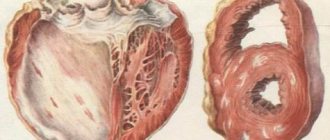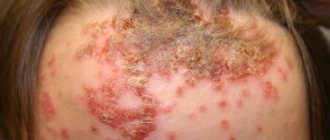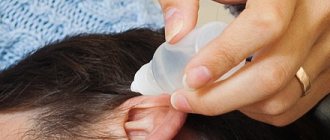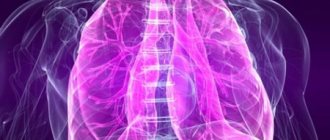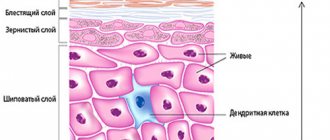Sputum consists mainly of mucus secreted by the epithelium of the trachea and bronchi.
A healthy person also secretes mucus, but in small quantities (about 100 milliliters per day). Mucus cleanses the airways. Normally, mucus is easily evacuated from the respiratory system through mucociliary transport (the so-called movement by oscillations of cilia covering the epithelium). Mucus is delivered from the bottom up through the respiratory tract to the pharynx; we swallow it, usually without noticing it.
In a pathological situation, there is a sharp increase in mucus production (up to 1500 milliliters per day). Sputum fills the lumen of the trachea and bronchi, interfering with breathing. Its evacuation occurs with the help of a cough (sputum has to be coughed out). The cough reflex is a normal reaction of the body to the sensation of obstruction in the respiratory tract.
Sometimes patients complain of sputum, but they do not have a cough. For example, in the morning you feel like your throat is clogged with phlegm - this usually happens with chronic inflammatory diseases of the nose. Thick mucus flows down the back wall and accumulates during sleep.
What is phlegm used for?
Sputum is a mixture of secretions from the paranasal sinuses, nasal mucosa, saliva and waste products of pathogenic microorganisms that cause inflammation in the lungs and bronchi. Mucus is necessary to “filter” any foreign substances that enter the respiratory system from the outside. In most cases, phlegm is beneficial. The exception is the abnormal release of formations that interfere with normal breathing.
Many patients at an appointment with a therapist or pulmonologist ask where does sputum come from? In fact, this question is not correct. Mucus is produced throughout life. If the ciliated epithelium stops transporting phlegm to the upper respiratory tract, then the risk of infectious infection of the lungs increases significantly.
What functions does sputum perform?
- protection of mucous membranes from microbes and allergens;
- moisturizing and eliminating irritation;
- removal of bacteria during therapy for acute respiratory viral infections, acute respiratory infections.
Normally, sputum consists of water, carbohydrates, protein and mineral salts. The pathological condition adds waste products of bacteria and viruses to the secretion.
Types and color of sputum
A healthy person daily gets rid of 50-100 ml of mucus, consisting of dust and other substances foreign to the body. During illness, the amount of phlegm produced can increase 10-15 times (1500 ml). Therefore, there is no need to worry too much when detecting mucus when coughing. This is believed to be a normal occurrence during treatment of viral and bacterial lesions.
It is necessary to seek help from a medical institution if the composition and color of sputum changes. A severe inflammatory process may be accompanied by the discharge of serous, purulent, bloody or glassy phlegm. Such symptoms often indicate the development of dangerous diseases of the respiratory system (tuberculosis, bronchitis, pneumonia, cancer).
Many doctors make an initial diagnosis based on the color of the sputum:
- clear discharge should not frighten the patient, since the absence of impurities indicates a gradual extinction of inflammation;
- glassy mucus should be a reason to check the body for the presence of bronchial stenosis;
- yellow sputum is considered an indicator of an increased fight by the immune system against infection (pneumonia, asthma, bronchitis);
- green discharge is usually viscous and difficult to expectorate due to an increased concentration of neutrophils, epithelium and dead pathogenic agents (staphylococcus, streptococcus);
- brown phlegm indicates spread of the disease to the lower respiratory tract or internal bleeding (ruptured capillaries).
Sputum with blood must be removed into a separate group. This symptom occurs when the lung tissue is severely damaged. Usually, patients with similar signs of the disease are immediately hospitalized.
Classification
The consistency of sputum can be thick, viscous or thin and watery. When settling, in some cases it is divided into 2 or 3 layers. Based on physical properties (color, smell, transparency, other macroscopic characteristics), the following types of sputum are distinguished:
- Serous.
Isolated in acute left ventricular failure accompanied by pulmonary edema. Characterized by the absence of odor, watery consistency, and an abundance of foam. Serous sputum is usually colorless, sometimes has a pinkish tint. - Mucous.
The appearance of mucous discharge indicates the onset of inflammation of the respiratory tract or the attenuation of the activity of an acute pathological process. Sputum is coughed up in small quantities and is colorless, viscous mucus. - Mucopurulent.
Formed in the acute period of many respiratory diseases. This type of secretion is characterized by increased viscosity and the presence of yellow or green impurities. - Purulent.
Appears with severe inflammation, suppurative processes of the respiratory system. The consistency of the purulent secretion is liquid, the color is green or yellow-green, and sometimes there is a putrid odor.
Purulent sputum
Other reasons for the formation and discharge of mucus when coughing
During the examination, the doctor will definitely ask a question about the time when the unpleasant symptom appeared. If sputum production is observed in the morning, then first of all it is necessary to exclude natural sources of phlegm. Often the cause of excessive discharge during coughing is an allergic reaction to external irritants (dust, dry air, animal hair). The possibility of poisoning from chemicals (fumes from household chemicals) cannot be ruled out.
Mucous, viscous sputum may form in smokers. With cigarette smoke, soot, soot and other toxic elements enter the lungs.
The negative effect on the bronchi causes a decrease in the respiratory lumen and a weakening of the functions of epithelial cells. The phlegm accumulated overnight comes out in the morning with a dry, paroxysmal cough.
Prevention
To prevent increased formation of sputum in the lungs, you must follow simple rules:
- Strengthen the immune system - toughen up, eat right, exercise, get enough sleep,
- Don't get too cold
- No smoking,
- Humidify the indoor air
- Avoid exposure to allergens and aggressive irritants,
- Sanitize infectious foci - caries, otitis media, sinusitis,
- Optimize your drinking regime.
Phlegm in the lungs is an alarming sign and a dangerous symptom, and if it appears, you should go to the doctor. Without qualified medical care, the pathological process will continue to develop and lead to irreversible, deadly consequences.
Diseases characterized by sputum production
Many respiratory tract diseases are accompanied by the formation of large amounts of secretion. Respiratory pathologies almost always provoke the body to produce phlegm. What pathologies need to be excluded first?
- Tuberculosis is a persistent infection caused by Koch bacilli. This disease is characterized by abnormal sweating, loss of appetite, and low-grade fever (37°C). A distinctive feature of the disease is white (initial stages), greenish or bloody sputum when coughing.
- Pneumonia develops due to infection of the lung tissue by bacteria, fungi or viruses. The main manifestations are a sharp jump in body temperature, a dry, unproductive cough with wheezing, chest pain, and shortness of breath. The secret is yellow or green.
- Bronchitis is characterized by swelling of the mucous membrane and accelerated production of immunoglobulin. Such processes cause blockage of the bronchi and complicated sputum production. Symptoms of the disease resemble the classic cold with the appearance of white, yellow or green phlegm.
Self-diagnosis is not allowed. Treatment should be prescribed by a specialist (therapist, infectious disease specialist, immunologist or pulmonologist).
Treatment process
Sputum in the lungs is a symptom of an underlying disease that needs to be eliminated. Treatment of most pulmonary pathologies is complex, including medication, physiotherapeutic procedures, traditional medicine, and, if necessary, surgical intervention.
Patients are advised to rest in bed in a room with humidified air and drink large amounts of warm alkaline liquid.
Medicines prescribed to patients:
- Antibiotics are selected based on the results of the antibiogram. The most commonly used penicillins are Amoxiclav, Augmentin, cephalosporins Suprax, Cephalexin, and macrolides Sumamed and Klacid.
- Antiviral drugs - Valtrex, Ingavirin, Arbidol.
- In some cases, antituberculosis, antimycotic and anthelmintic drugs are used.
- Mucolytic and expectorant drugs make it possible to remove phlegm from the lungs faster and easier . It liquefies and freely leaves the respiratory system. Patients are prescribed "Fluimucil", "Ambroxol", "ACC".
- To combat bronchial obstruction, bronchodilators “Sulbutamol”, “Berodual” and corticosteroids “Pulmicort”, “Benacort” are used.
- In cancer processes, you cannot do without cytostatics - Methotrexate, Cyclophosphamide.
Drug therapy is often complemented by physiotherapeutic procedures. Patients are shown inhalations, breathing exercises, and percussion chest massage.
There is a wide variety of folk remedies that allow you to remove phlegm from the lungs and relieve the symptoms of the pathological process. The most effective and common among them are:
Inhalation of vapors of essential oils - eucalyptus, fir, pine, sandalwood,- Inhalations with a decoction of chamomile, sage, calendula, lemon balm,
- Inside, aloe juice with honey and butter,
- Radish with honey
- A mixture of honey and lemon,
- Ginger tea.
Surgical treatment is performed for patients with destructive lung diseases in which purulent sputum is produced abundantly. Surgery along with radiation and chemotherapy is indicated for neoplasms. The tactics of surgeons are determined by the localization of the lesion, the degree of destruction of the lung tissue, and the nature of the pathology. Typically a segment, lobe, or entire lung is removed.
Indications for sputum analysis
It is necessary to seek help from a medical facility if the cough continues for more than 2 weeks, there is a suspicion of pneumonia, tuberculosis or other dangerous diseases, or there are impurities in the sputum (pink, green, yellow or glassy mucus).
Phlegm analysis allows:
- accurately determine the cause of increased mucus production;
- exclude oncology (lung cancer);
- check discharge for allergy markers.
When the bacterial nature of sputum is identified, the laboratory conducts studies on the resistance of pathogenic microflora to various types of antibiotics.
Diagnostics
To get rid of phlegm in the lungs, it is necessary to identify and eliminate the causative disease. To do this, doctors collect anamnesis, listen to complaints, study clinical signs, and conduct a physical examination, including palpation, percussion, and auscultation. The data obtained allow us to suspect a disorder in the patient. To confirm this or that hypothesis, the results of hardware research and laboratory analyzes are needed.
- UAC - neutrophilic leukocytosis or eosinophilia, anemia, elevated ESR.
- OAM are signs of intoxication in the form of proteinuria or symptoms of damage to the urinary organs in the form of changes in the physicochemical parameters of urine.
- Microscopy of sputum - detection of blood cells, pus, microbial cells and other atypical inclusions in it.
- Microbiological examination of sputum for microflora - isolating the causative agent of infection and determining its sensitivity to antibiotics.
- Serological reactions are the detection in the patient’s blood of antibodies to pathogens of bacterial infections.
- PCR is an accurate and rapid identification of a pathogen by detecting its DNA in biomaterial.
- To confirm tuberculosis, a Mantoux test or Diaskintest is performed.
- Allergy testing is the identification of the allergen that provoked the development of the corresponding reaction.
- Molecular genetic counseling is carried out if a hereditary disease is suspected.
- X-ray of the chest organs - infiltration of lung tissue, destructive processes, syphilitic gummas or tuberculous cavities.
- Bronchoscopy - examination of the mucous membrane of the bronchi and trachea; identification of endoscopic signs of bronchitis, bronchiectasis, bronchostenosis; performing a biopsy of suspicious areas.
- Computer or magnetic resonance imaging - determining the location of the pathological focus.
Analysis of sputum with determination of its organoleptic and rheological properties is of great importance and helps to make a final diagnosis.
- There is normally no smell. With the generalization of the process and the addition of pyogenic flora, the sputum becomes fetid. This is typical for lung abscess, gangrene, pleural empyema.
- Pathological impurities in sputum - pus, blood, tumor cells.
- The consistency is liquid, watery or viscous, jelly-like, difficult to separate when coughing.
Additional research methods are: gastroscopy, rhinoscopy, spirometry, body plethysmography. Therapeutic and diagnostic measures are carried out by specialists in the field of pulmonology and general therapy.
